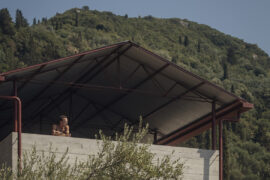As the Escher x nendo | Between two worlds exhibition continues to draw in crowds, we consider the timeless appeal of the Dutch master for architects and designers.

M. C. Escher: Convex and concave March 1955, lithograph. Escher Collection, Gemeentemuseum Den Haag, The Hague, the Netherlands © The M. C. Escher Company, the Netherlands. All rights reserved.
Paper architecture is a practice of drawing and designing, without the goal of ever building. On the page one can dream up a visionary or utopian idea for what a building, or even a city could look like.
It’s a big call but I’m going to go so far as saying that 20th-century Dutch artist M.C. Escher was the original paper architect.

M. C. Escher: Belvedere May 1958, lithograph. Escher Collection, Gemeentemuseum Den Haag, The Hague, the Netherlands © The M. C. Escher Company, the Netherlands. All rights reserved.
Most would recognise Escher’s work from his iconic optical illusions but there is much more to his body of work than staircases leading to nowhere. Escher was able to not only push the boundaries of what is possible in a drawing, but also what is possible in architecture. His work was well ahead of its time, featuring towers held up by impossibly spindly piloti, or axonometrics with multiple vanishing points.

M. C. Escher: Day and night February 1938, woodcut, printed in grey and black inks Escher Collection, Gemeentemuseum Den Haag, The Hague, the Netherlands © The M. C. Escher Company, the Netherlands. All rights reserved.
Commenting on the influence of Escher’s foresight on the architectural world, Tony Ellwood AM, director at the NGV says, “Escher’s artistic practice, due to its complex play with space, logic and mathematics, has had an indelible impact on architecture and design for many generations. This rich legacy was the catalyst for the NGV to conceptualise the idea of pairing Escher with nendo. We can’t wait for audiences to explore how art can be perceived and experienced differently through the lens of design.”

M. C. Escher: Ascending and descending March 1960, lithograph. Escher Collection, Gemeentemuseum Den Haag, The Hague, the Netherlands © The M. C. Escher Company, the Netherlands. All rights reserved.
From the exhibition design side of things, Japanese powerhouse studio nendo, fronted by Oki Sato, has taken reference and inspiration from the conceptual background of Escher’s work.
The result is a combination of thoughtful exhibition design and inspirational artistic work. And nendo’s execution of the final design is not without surprises.
Escher X nendo | Between Two Worlds is open at the National Gallery of Victoria until 7 April 2019.
INDESIGN is on instagram
Follow @indesignlive
A searchable and comprehensive guide for specifying leading products and their suppliers
Keep up to date with the latest and greatest from our industry BFF's!

The undeniable thread connecting Herman Miller and Knoll’s design legacies across the decades now finds its profound physical embodiment at MillerKnoll’s new Design Yard Archives.

For Aidan Mawhinney, the secret ingredient to Living Edge’s success “comes down to people, product and place.” As the brand celebrates a significant 25-year milestone, it’s that commitment to authentic, sustainable design – and the people behind it all – that continues to anchor its legacy.

London-based design duo Raw Edges have joined forces with Established & Sons and Tongue & Groove to introduce Wall to Wall – a hand-stained, “living collection” that transforms parquet flooring into a canvas of colour, pattern, and possibility.

The Melbourne-based artist works at the intersection of art and architecture. In a new exhibition at MAGMA Galleries, he turns his focus on urban space and agency to a smaller scale.

The Finding Infinity Principal comments here on the question of balance in city life, with architecture and design highlighted as the key levers for making change.
The internet never sleeps! Here's the stuff you might have missed

Whether you’re an architect, interior designer or student eager to learn, the 2025 Design Discussion series at Saturday Indesign will inspire fresh perspectives. Check out the schedule now!

Dr Piers Taylor – award-winning British architect, BBC presenter and founder of Invisible Studio – returns to Australia to deliver a keynote at the inaugural Glenn Murcutt Symposium.